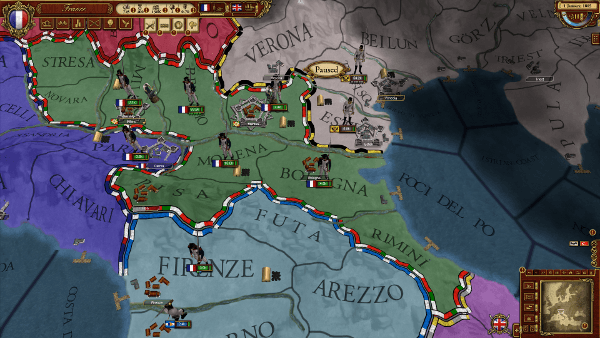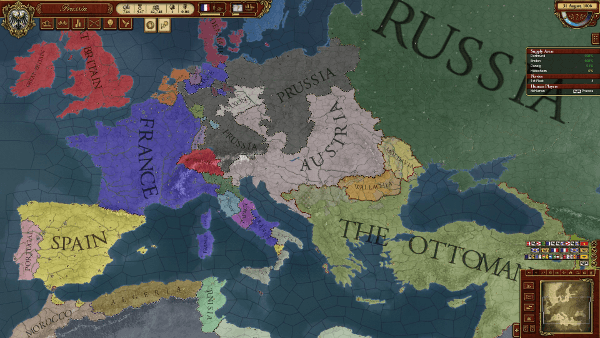- Wondering how to get Monopoly GO! free rolls? Well, you’ve come to the right place. In this guide, we provide you with a bunch of tips and tricks to get some free rolls for the hit new mobile game. We’ll …
Best Roblox Horror Games to Play Right Now – Updated Weekly
By Adele Wilson
Our Best Roblox Horror Games guide features the scariest and most creative experiences to play right now on the platform!The BEST Roblox Games of The Week – Games You Need To Play!
By Sho Roberts
Our feature shares our pick for the Best Roblox Games of the week! With our feature, we guarantee you'll find something new to play!All Grades in Type Soul – Each Race Explained
By Adele Wilson
Our All Grades in Type Soul guide lists every grade in the game for all races, including how to increase your grade quickly!
March of the Eagles Review
The Duke of Wellington was a great general, but he wasn’t distracted by the need to look after Britain’s Industrial output or cultural heritage. His King, George III, had some qualities as a monarch, but didn’t have to busy himself with the precise disposition of the brigades in his peninsular armies. To succeed in March of the Eagles, you’ll have to do all this and more by yourself.

Marching unto confusion
The Duke of Wellington was a great general, but he wasn’t distracted by the need to look after Britain’s Industrial output or cultural heritage. His King, George III, had some qualities as a monarch, but didn’t have to busy himself with the precise disposition of the brigades in his peninsular armies. To succeed in March of the Eagles, you’ll have to do all this and more by yourself.
A curious mix between a grand strategy title and a war game, it places you in command of a European nation at the outbreak of the Napoleonic wars. You’ll control the spending of tax revenues on national improvements, ideas, and the military. Diplomats will do your bidding to try and forge alliances or secure sympathetic treatment from neutral nations. But mostly you’ll be pushing huge armies and navies back and forth across the map, attempting to take and hold the ports and cities your nation requires for victory.
It might sound simple. After you’ve looked at the relatively small number of buttons and menus on the screen and had a jaunt round the short interactive tutorial it might even look simple. Looks are deceptive. It’s not simple.
The amount of stuff here you have to plan and manage is staggering. Control a major nation like Russia or France and you’ll have charge of a vast spread of provinces, unfurling before you on the beautiful, crisply rendered map like the patchwork of a seemingly endless duvet. You can build in any of them. You’ve got to guard all of them. You’ll have no idea where to start.
Overwhelmed by the options on offer, you might take the familiar route of declaring war on a neighbour, gathering the considerable standing armies the big nations start with and sending them in. First you’ll discover that the fog of war effect, which can hide very large enemy armies from view right up until they attack, demands you approach any campaign with considerable tactical nous rather than just rounding up the troops and getting stuck in.
Then you’ll find out that your armies are made up of a wide mix of brigade types, distributed across three flanks and a reserve, each section commanded by a general with unique stats and abilities. You’ll find out that you can pre-set the behaviour and tactics of your army for a fight in the field. You’ll discover that getting these wrong can lead to a smaller force routing a larger one with ignominious ease.
You’ll observe that the fragments of your shattered forces split up and retreat back to your borders, and realise that if you ever want to conquer anyone you’ll be chasing tiny pieces of their once-mighty armies across the map for hours. You’ll note that it takes many weeks of game time to rebuild your military and see that planning for your losses is the first thing you should really do before you start a campaign.
At this point you will either melt with ecstasy, or fall to weeping bitter tears.
This is effectively everything that’s both good and bad about March of the Eagles. It sells itself as a good introduction to the grand strategy genre, with a simple interface, good tutorial, several beginner’s guide-type booklets online and a militaristic focus. But the scope of what the game covers remains bewilderingly vast, and considerable micromanagement is still required for success.
However, by scaling back on its options and pushing the importance of warfare, there’s a danger it’ll prove unsatisfying to the core grand strategy audience. Walking a sometimes wobbly line between two genres, it’s less an introduction to grand strategy as it is an effective tool for sorting gamers into those who might like that genre and those who’ll run screaming back to their gamepads.
One thing that might convince the terrified to give this game another shot is the multiplayer mode. It’s hard to organise games: for a long-running, passable experience, something like a LAN party is probably your best bet. And while the AI on offer is competent, it can match neither the skill nor the thrill of playing against flesh and blood opponents.
If it does coax anyone back into playing and completing a game, they’ll find there’s a lot to like about March of the Eagles. Marrying elements of empire management with martial manoeuvre is an old-school approach that got rather sidelined by the more specialist genres of grand strategy and historical war games. But this game proves there’s still a lot of life left in it. It’s just a shame there’s quite so much hard graft required to find that out.

The good

The bad
More articles...
Monopoly GO! Free Rolls – Links For Free Dice
By Glen Fox
Wondering how to get Monopoly GO! free rolls? Well, you’ve come to the right place. In this guide, we provide you with a bunch of tips and tricks to get some free rolls for the hit new mobile game. We’ll …Best Roblox Horror Games to Play Right Now – Updated Weekly
By Adele Wilson
Our Best Roblox Horror Games guide features the scariest and most creative experiences to play right now on the platform!The BEST Roblox Games of The Week – Games You Need To Play!
By Sho Roberts
Our feature shares our pick for the Best Roblox Games of the week! With our feature, we guarantee you'll find something new to play!All Grades in Type Soul – Each Race Explained
By Adele Wilson
Our All Grades in Type Soul guide lists every grade in the game for all races, including how to increase your grade quickly!








 “
“